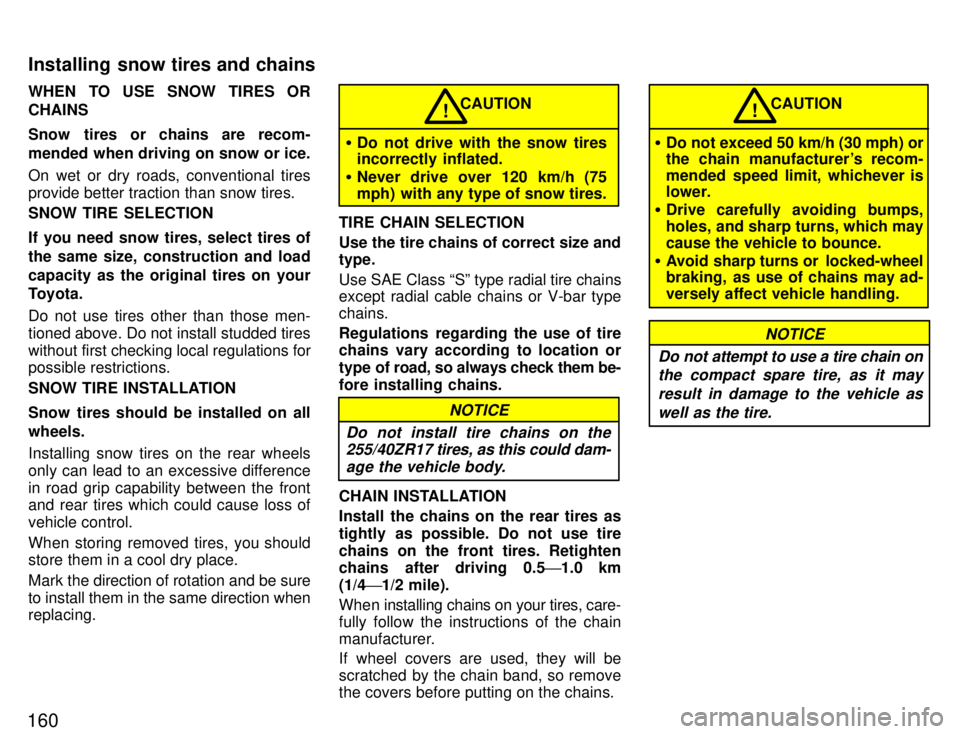Page 162 of 188

160WHEN TO USE SNOW TIRES OR CHAINS
Snow tires or chains are recom-
mended when driving on snow or ice.
On wet or dry roads, conventional tires
provide better traction than snow tires. SNOW TIRE SELECTION
If you need snow tires, select tires of
the same size, construction and loadcapacity as the original tires on your
Toyota.
Do not use tires other than those men-
tioned above. Do not install studded tires
without first checking local regulations for
possible restrictions.
SNOW TIRE INSTALLATION
Snow tires should be installed on all wheels.
Installing snow tires on the rear wheels
only can lead to an excessive difference
in road grip capability between the front
and rear tires which could cause loss of
vehicle control.
When storing removed tires, you should
store them in a cool dry place.
Mark the direction of rotation and be sure to install them in the same direction when replacing.
�
Do not drive with the snow tires
incorrectly inflated.
� Never drive over 120 km/h (75
mph) with any type of snow tires.
CAUTION!
TIRE CHAIN SELECTION Use the tire chains of correct size and type. Use SAE Class Sº type radial tire chains
except radial cable chains or V-bar type chains.
Regulations regarding the use of tire
chains vary according to location or
type of r oad, so always check them be-
fore installing chains.
Do not install tire chains on the
255/40ZR17 tires, as this could dam-
age the vehicle body.
NOTICE
CHAIN INSTALLATION
Install the chains on the rear tires as
tightly as possible. Do not use tirechains on the front tires. Retighten
chains after driving 0.5 '1.0 km
(1/4 '1/2 mile).
When installing chains on your tires, care-fully follow the instructions of the chain
manufacturer.
If wheel covers are used, they will be
scratched by the chain band, so removethe covers before putting on the chains.
� Do not exceed 50 km/h (30 mph) or
the chain manufacturer's recom-
mended speed limit, whichever is
lower.
� Drive carefully avoiding bumps,
holes, and sharp turns, which maycause the vehicle to bounce.
� Avoid sharp turns or locked-wheel
braking, as use of chains may ad-
versely affect vehicle handling.
CAUTION!
Do not attempt to use a tire chain on
the compact spare tire, as it may
result in damage to the vehicle as well as the tire.
NOTICE
Installing snow tires and chains
Page 163 of 188

161
WHEN TO REPLACE YOUR WHEELS
If you have wheel damage such as
bending, cracks or heavy corrosion,
the wheel should be replaced.
If you fail to replace damaged wheels, the
tire may slip off the wheel or they may cause loss of handling control. WHEEL SELECTION
When replacing wheels,
care should be
taken to ensure that the wheels are re- placed by ones with the same load ca-
pacity, diameter, rim width, and offset. This must be observed on compact spare
tires, too.
Correct replacement wheels are available
at your Toyota dealer.
A wheel of a different size or type may ad-
versely affect handling, wheel and bear-
ing life, brake cooling, speedometer/
odometer calibration, stopping ability,
headlight aim, bumper height, vehicle
ground clearance, and tire or snow chainclearance to the body and chassis. Replacement
with used wheels is not rec-
ommended as they may have been sub-jected to rough treatment or high mileageand could fail without warning. Also, bent
wheels which have been straightened
may have structural damage and there-
fore should not be used. Never use an in-
ner tube in a leaking wheel which is de-
signed for a tubeless tire. �
After driving your vehicle the first 1600
km (1000 miles), check that the wheel
nuts are tight.
� If you have repaired or changed your
tires, check that the wheel nuts are still
tight after driving 1600 km (1000miles).
� When using tire chains, be careful not
to damage the aluminum wheels.
� Use only the Toyota wheel nuts and
wrench designed for your aluminumwheels.
� When balancing your wheels, use only
Toyota balance weights or equivalent
and a plastic or rubber hammer.
� As with any wheel, periodically checkyour aluminum wheels for damage. If
damaged, replace immediately.
Replacing wheels
Aluminum wheel precautions
Page 184 of 188

182STEERING Wheel freeplay:
Less than 30 mm (1.2 in.)
Power steering fluid type: Automatic transmission fluid DEXRON )
-II or -III Tire size:
Spare tireT145/70 R 17
Except spare tire 2JZ-GE engine
225/50R 16 (for front use only) 245/50R 16 (for rear use only)
2JZ-GTE engine
235/45 ZR 17 (for front use only)255/40 ZR 17 (for rear use only)
Tire pressure, kPa (kgf/cm 2
or bar, psi):
Spare tire 420 (4.2, 60)Except spare tire 225/50 ZR 16 230 (2.3, 33)
others 250 (2.5, 36)
Wheel size:
225/50 ZR 16 16 x 8JJ
245/50 ZR 16 16 x 9JJ
235/45 ZR 17 17 x 8JJ
255/40 ZR 17 17 x 9.5JJ
T145/70 R 17 17 x 4T
Wheel nut torque, N Vm (kgf Vm, ft Vlbf):
103 (10.5, 76)
Fuses (type A)
1. WIPER 20 A: Windshield wipers and
washer, rear window wiper and washer
2. HTR 7.5 A: Air conditioning system
3. SEAT-HTR 7.5 A: Seat heater
4. ST 7.5 A: Starter system
5. IGN 7.5 A: Charging system, dis-
charge warning light, multiport fuel injec- tion system/sequential multiport fuel in-
jection system, SRS airbag system
6. PANEL 10 A: Instrument panel lights,
instrument panel lights control
7. MIR-HTR 10 A: Mirror heaters
8. TURN 7.5 A: Turn signal lights
Tires Fuses